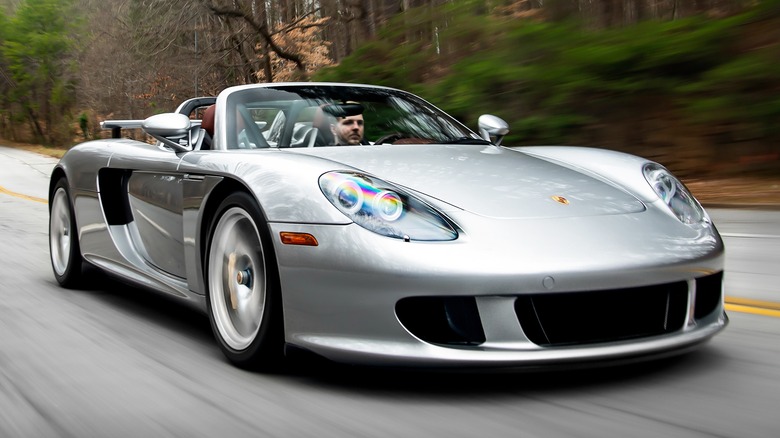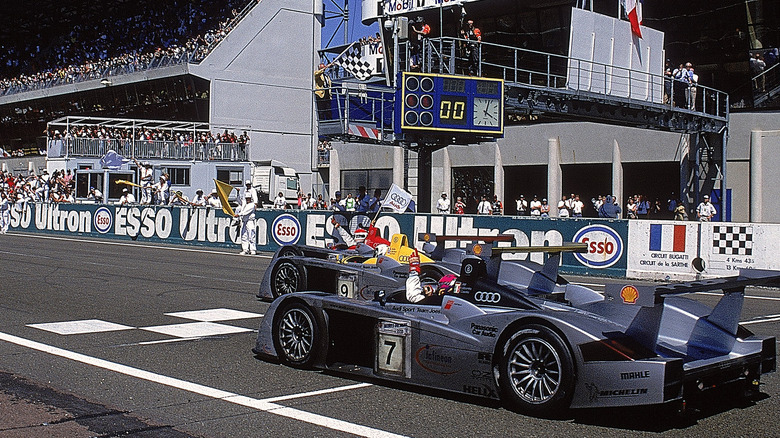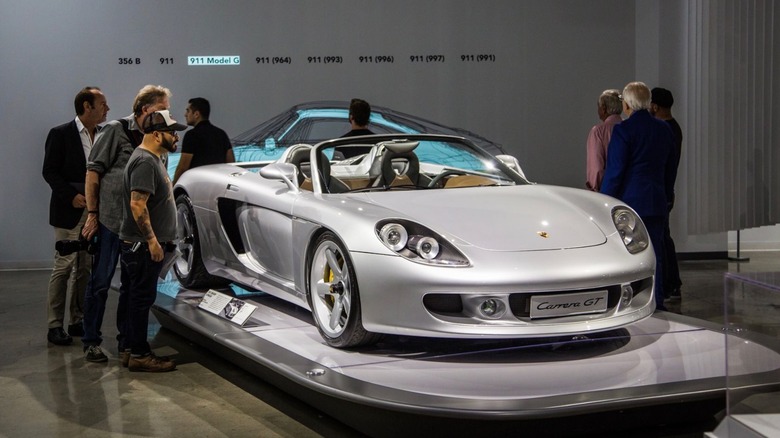Here's What Made The Porsche Carrera GT's V10 Engine So Special
A motorsport backstory always adds something to the allure (and value) of a supercar. The McLaren F1's unexpected debut win at Le Mans is a prime example, and so too of course are the racing exploits of members of the Ferrari 250 family.
Even unsuccessful racing campaigns add value to a supercar's story, and this is where the Porsche Carrera GT comes in. Revealed in concept form in 2000 and produced between 2004 and 2006, the Carrera GT is a two-seat, mid-engined supercar. Limited to 1,270 examples, the car was priced at $440,000 when new, and after hovering around the $800,000 mark from 2018 through 2021, the last 18 months have seen prices leap through the $1m and even the $1.5m barrier, according to data compiled by Classic.com.
Although undeniably attractive, what really makes the Porsche Carrera GT stand out from a crowd of analog supercars from the late 1990s and early 2000s is its motorsport-derived V10 engine.
Stillborn Le Mans project
Porsche likes to say how the Carrera GT's engine is closely related to a Le Mans racer – "a direct descendant of the 10-cylinder race engine developed for the Le Mans 24-hours of 2000," the company says. But, while this is true, the engine never went to the famous French endurance race, as the Porsche 9R3 LMP2000 racer it was fitted to was canned after just one test session.
Only one example was built, and although drivers Alan McNish and Bob Wolleck said it was quick, it is claimed by Stuttcars that Volkswagen Audi Group boss Ferdinand Piëch pulled the plug so that Audi and its successful R8 could be left unchallenged at Le Mans, and Porsche could instead spend money developing the then-new Cayenne SUV. The R8 is pictured above, winning Le Mans in 2000.
The story of the Carrera GT's V10 goes even further back than that, as the 9R3 Le Man racer's power plant was actually a development of another stillborn engine, a V10 intended for Formula One. Developed by Porsche, that engine briefly appeared in the unsuccessful Arrows FA12 for the 1992 season, before being replaced after just a handful of races by a more reliable unit from Ford-Cosworth.
A Parisian debut
Porsche revealed the Carrera GT in concept form at the 2000 Paris motor show, hours after two-time World Rally champion Walter Röhrl drove the one-off car through the French capital in the dead of night, complete with police motorcycle escort.
Three years later, a production version of the Carrera GT was revealed at the 2003 Geneva motor show. The engine — which, remember, had begun life as a failed Formula One project in the early 1990s, then failed to reach Le Mans a decade later — now had its chance to succeed.
Now producing 604 horsepower from 5.7 liters of naturally-aspirated displacement, the V10 propelled Porsche's new supercar to 62 mph in 3.9 seconds, 124 mph in 9.9 seconds, and a top speed of 205 mph. These figures may be dwarfed by today's 2,000-horsepower electric hypercars like the Rimac Nevera, but for something produced 20 years ago, this performance is still impressive. The Porsche engine is attached to a six-speed manual transmission with a shift knob unusually made out of beech wood — a feature seen on Porsche racers of the 1960s and 1970s because of the slow transfer rate of heat from the gearbox to the driver's hand.
What about the clutch?
First impressions by the media were excellent. The UK's CAR magazine described the Carrera GT as "expletive-inducingly quick," while Car and Driver remarked: "That free-revving engine is unlike anything else we've ever sampled. It's loud...the kind that prickles your body hair. The power peak is high as is the torque, but the engine is quite flexible."
But no article about the Porsche Carrera GT is complete without a mention of the clutch. Porsche sought to produce one that was as small and light as possible, thus lowering weight, the position of the engine, and the center of gravity in a bid to improve driving dynamics. The result was the world's first ceramic two-plate dry clutch with a plate diameter of 6.65 inches. Porsche says: "This extremely strong clutch is especially compact and makes it possible to achieve a very low center of gravity".
It was half the size and weight of a contemporary Porsche 911 Turbo clutch, says Sterling Sackey, an automotive auction house that goes on to say how Porsche updated the car's anti-stall technology throughout the years, installing new code as the cars came in for regular servicing. Sterling Sackey adds: "The complaints about the Carrera GT's clutch usually come from owners, or more likely, one-time drivers, who don't know how to use this anti-stall system properly — use no throttle input, simply let the clutch out until it just reaches the bite point, and hold there as the computer meters the throttle appropriately."



